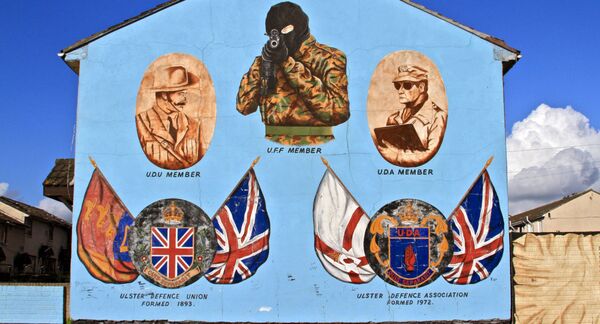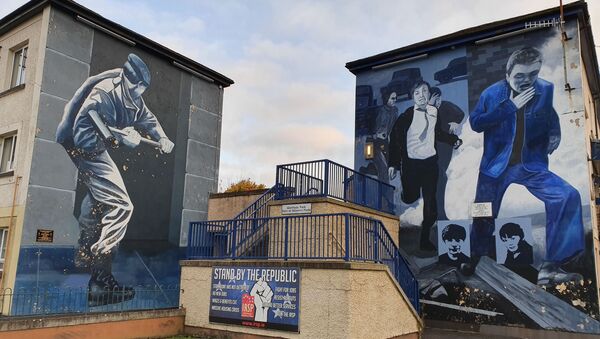UK Prime Minister Boris Johnson is in Northern Ireland to meet the newly appointed First Minister Arlene Foster and Deputy First Minister Michelle O'Neill and give his blessing to the new power-sharing executive.
Ahead of his visit Mr Johnson said: "This is an historic time for the people of Northern Ireland. The next decade will be an incredible time of opportunity for Northern Ireland and the whole of the United Kingdom as we come together to unleash the potential of our four nations.”
I congratulate those in Northern Ireland who have worked to reach agreement to allow a return to power sharing at Stormont.
— Jeremy Corbyn (@jeremycorbyn) January 10, 2020
The Good Friday Agreement and peace process in Northern Ireland is a proud Labour legacy we are committed to support and protect.
One key part of the deal was an agreement to put through new legislation which will deal with hundreds of so-called "legacy" cases from The Troubles, the period between 1969 and 1998 when 3,600 people died in political and sectarian violence.
So what are some of the key “legacy” cases which have yet to have inquests or public inquiries?
Murder of Roseanne Mallon - 1994
By the early 1990s loyalist paramilitaries were killing more people than the IRA and many of their victims were innocent members of the Roman Catholic community, many of whom were targeted because they were related to figures within IRA or Sinn Fein.
Pensioner Roseanne Mallon was 76 when see was murdered by loyalists in 94.
— Mark Malone (@soundmigration) January 7, 2019
I'll link more info on the case and the inquiry report today in the thread.
But let's be clear
Its most likely that Garda Commissioner Drew Harris specifically knows if Billy Wright was a state agent. pic.twitter.com/BF9FTpbON2
One of those was Roseanne Mallon, a 76-year-old spinster, who was gunned down as she sat watching television in her home in Killymoyle, County Tyrone.
It later turned out her home was overlooked by a British Army surveillance position.
Miss Mallon’s killers are believed to have been members of the Loyalist Volunteer Force (LVF), led by Billy Wright, a paramilitary leader known as “King Rat” who was assassinated in jail three years later.
An inquest would be bound to hear evidence about whether the UK security forces colluded with the LVF.
Miss Mallon’s nephew Martin, was an Irish republican who had been jailed for possessing explosives, and he told the BBC in 2009: “This was part of an ongoing campaign. We want to find out what happened and why. We want justice."
SAS Ambush at Coagh - 1991
In the latter stages of The Troubles the UK security forces became increasingly successful in recruiting double agents within the IRA, who would be willing to pass on information in return for money or immunity.
That is believed to be how the British Army learned in 1991 that an IRA “active service unit” was about to carry out an attack.
Coagh Ambush, 1991. SAS murdered 3 Irish volunteers. The car burst into flames, 2 were put back inside the car. pic.twitter.com/VpozfXCzSI
— Crimes of Britain (@crimesofbrits) July 18, 2015
An SAS unit ambushed the IRA gang in the village of Coagh in County Tyrone and shot three men dead, including a man called Peter Ryan.
In 2009 Mr Ryan's brother, Sean, told the BBC there was evidence which suggests some of the men were finished off in cold blood, rather than being arrested.
Mr Ryan said: "There were a number of ambushes like that where all the IRA men died. Nobody was going to come out of there alive. It was a very direct policy. There were to be no survivors."
Loughgall Ambush - 1987
In May 1987 an IRA gang attacked Loughgall police station in County Armagh.
A digger smashed into the base and set off a bomb, which destroyed the police station, and other terrorists fired shots at the base.
The Loughgall Martyrs fought and died (as did many before and after them) for a United, Gaelic and Free Ireland NOT to upload British Rule - NOT to administer British Rule and certainly NOT to Serve a British Crown - simple as 🇮🇪🇮🇪🇮🇪https://t.co/WfFwppzEQN pic.twitter.com/bB2x6d1zpc
— Loughgall Campaign (@loughgall87) January 11, 2020
But the police station had been evacuated in advance, after the security forces received a tip-off from a mole within the IRA.
Seconds later an SAS unit ambushed the attackers, gunning down all eight of them. It was the IRA’s biggest loss of life in The Troubles.
The Kingsmill Massacre - 1976
In January 1976 gunmen stopped a minibus carrying 11 workmen at Kingsmill as they travelled home a textiles factory.
When one of the gunmen asked: "Who is the Catholic?" the workers presumed they were a loyalist gang and feared for the life of the only Catholic in the bus, Richard Hughes.
But the gunmen were from the IRA and Hughes was to be the only survivor of the massacre, which caused outrage among the loyalist community.
In 2018 Sinn Fein MP Barry McElduff was forced to resign after he tweeted a video of himself with a loaf of Kingsmill bread on his head, which was widely seen as an insult to the dead.
The Shankill Bombing - 1993
On 23 October 1993 two IRA men, Thomas Begley and Sean Kelly, carried a bomb into Frizzell’s fish and chip shop on the Shankill Road in Belfast, the heart of the Protestant community.
It was later alleged the IRA believed the leadership of the loyalist Ulster Defence Association (UDA) was attending a meeting in a room above the shop.

The bomb detonated prematurely, killing Begley and eight other people - including Michael Morrison, 27, his partner Evelyn Baird, 27, and their daughter, Michelle, seven, who were all queuing up for fish and chips.
There was outrage among the Protestant community, especially when Sinn Fein leader Gerry Adams was seen carrying the coffin of Begley at his funeral.
A few days later the UDA carried out a horrific sectarian massacre in revenge for the bombing.
UDA gunmen entered the Rising Sun bar in Greysteel, near Londonderry, shouted: “Trick or treat” and sprayed the Catholic customers with bullets, killing eight people and wounding 19.
The Loughinisland Massacre - 1994
In 1994 gunmen from the Ulster Volunteer Force (UVF) burst into The Heights Bar in the village of Loughinisland, who were watching the Republic of Ireland on television, playing Italy in the World Cup.
The massacre was blatantly sectarian and nobody has ever been brought to justice for it.
There is a widespread belief in the nationalist community that there was collusion between the UVF and the security forces.
In 2018 Alex Gibney's documentary, No Stone Unturned, claimed there had been collusion with the security forces and that same year two journalists investigating the massacre were arrested by police.
The ‘Good Neighbour’ Bombing - 1988
On 25 August 1988 an IRA gang took over a house on the Creggan estate in Derry and abducted the owner.
They planted a booby-trapped bomb in the property, intending to kill police officers who would be called to the house.
The police did not fall for the ruse but six days later neighbours called at the house, because they were worried about the occupant, who they had not seen for several days.
The bomb was triggered, killing Sean Dalton and Sheila Lewis. Another neighbour, Thomas Curran, was seriously injured.
The IRA apologise for the “mistake” but six years later Mr Dalton’s family complained to the police ombudsman, claiming the Royal Ulster Constabulary had known about the device and had been negligent in allowing the neighbours to approach the house.
Plastic Bullet Killings - 1973 and 1975
Rioting was commonplace during The Troubles and in the 1970s the security forces often reacted by firing plastic or rubber bullets at or over the crowd.

They were not mean to be lethal but in 1975 a 10-year-old boy, Stephen Geddis, was hit by a plastic bullet fired by the British Army and died of his injuries.
Two years earlier Thomas Friel, 21, died after being hit by a rubber bullet fired by soldiers during disturbances on the notorious Creggan estate.
Neil McConville - 2003
The vast majority of “legacy” inquests refer to deaths before the signing of the Good Friday Agreement.
But some post-date it, as is the case with Neil McConville, 21, who was shot by the Police Service of Northern Ireland as he tried to evade police near Lisburn, County Armagh, in 2003.
McConville was suspected of being armed with a weapon.
The PSNI has since admitted it mistakenly destroyed the gun one of its officers used to kill McConville.




